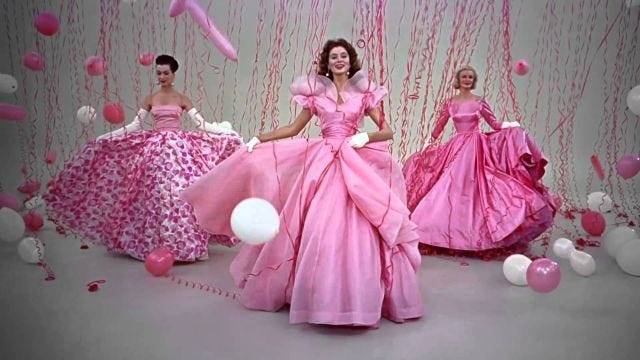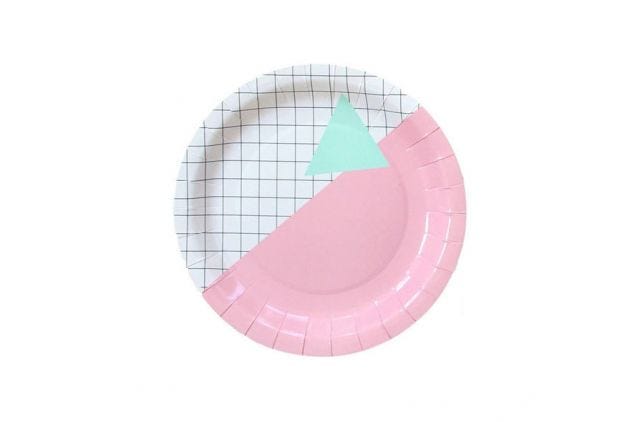So What, Who Cares (vol 3, issue 25) What we think when we "think pink!"
Hello!
I have just discovered that nearly every Absolutely Fabulous episode ever made is streaming on Netflix. Tell my family I love them and I'll see them again someday.
*

My favorite part of the movie Funny Face is the "Think Pink!" number where the autocratic editor of Quality, Maggie Prescott, decides to render the wardrobes of American womanhood completely irrelevant in one master stroke: "Banish the black, burn the blue, and bury the beige." Just as Dior's New Look managed to radically shift the eye -- and subsequently the perception of chic -- toward a whole new silhouette, so does Miss Prescott's judgment that "red is dead, blue is through, green's obscene, and brown's to boo" reset the palette of colors women are supposed to wear.
The pink in the 1957 movie has the creamy, saturated quality of a bouquet of hothouse peonies, and when I watched the final frames of the "Think Pink" sequence, I was struck by the thought, "What would happen if someone made that movie today? How would Millennial Pink play in a musical number? Would everyone politely clear their throat and wait for Miss Prescott to notice that she likely found the pink by scrolling through a social media feed full of blush-colored water bottles and rose-splattered coffee cups?"
For those of you not fluent in It Tints: Millennial pink is the pale, blush-peach-salmon-baby pink hue that's on everything from home goods to tote bags. It's also known as Tumblr Pink or Rose Quartz. We were warned to expect it in fall 2015, when Pantone decreed it to be one of the colors of the year for 2016.

And Pantone's color forecasters looked like geniuses when it broke out big. According to color forecasters, this pink was the right hue at the right time: the muted tone reflects "society's understanding of femininity ... changing the way people think about the female experience."
As a result of its timeliness, millennial pink is the icy hue that refuses to go away in 2017 -- it's selling bigger than anything in green, which was supposed to be the It Color for 2017, a sort of "Well, that was a crazy year! Aren't we all glad we're chill and into saving the environment now?" palate cleanser after society had finished wrestling with questions of how we define gender.

Because we live in a remix culture, millennial pink may actually be bending back upon itself like some candy-colored mobius strip: The pallid shade is sometimes traced back to a very specific 1980s look, and the Memphis group's 1980s aesthetic -- think geometrics, color-blocking and neon-infused pastels -- is roaring back into lifestyle media. Blogs are dutifully churning out commerce-centered pieces trying to sell the aesthetic as improved from the 1980s Miami Vice looks. And when Etsy's got your aqua-triangle-on-a-pink-grid party plates covered, you know a look is here to stay.

So what? Color is big business. Pantone makes a big press event out of announcing its color of the year, and it makes big money selling its specific shades and their corresponding formulas to everyone from apparel designers to paper goods manufacturers. While it had pegged 2017 as the year of Greenery, "a refreshing and revitalizing shade, Greenery is symbolic of new beginnings," and design blogs have all done the desultory product round-ups in the spring-y hue, pink is still hanging on -- and mutating. As Buzzfeed's Jessica Testa wrote of the Girlboss Rally in Los Angeles:
There were no blinding-hot pink "pussyhats" here — rather the numb, pale “millennial pink” was everywhere: on their dresses and blazers and bags and the badges around their necks, on the walls around them, and painted on once naturally green houseplants in every corner.
The very mention of the hot pink hats -- and the way they ripped through the media in January -- shows that sometimes, a year's chosen hue, Pantone's "color snapshot of what we see taking place in our global culture that serves as an expression of a mood," can be overtaken by the actual mood of the global culture. It'll be interesting to see how Pantone takes the temperature for 2018.

Who cares? People who trawl through home-goods aisles and wonder why everything seems to be in shades of gray with a "pop of color"? This sort of color trend-watching is useful if you're in the market to make a big purchase -- Tumblr pink refrigerators exist in the wild, and only history can tell if they'll be the "harvest gold" kitchen regret of the 2030s.
Color is one of the strongest signifiers of an era, and it seems only appropriate that as we move deeper into the post-Obama era, we move past the pink that goes along with the big-data-diving campaigns, the government websites that promised citizen access and transparency, and a sense that we could detach the strategic deployment of technology from real-world consequences.
*

Your pop culture recommendation for the day: The woman who plays Maggie Prescott in Funny Face is Kay Thompson, whom non-cinemaphiles may better know as "the writer of Eloise books.*"
Combining her two great interests? This novelty song "Eloise," where Kay Thompson channels a six-year-old while a group of soporific tenors cooes, "El-ohhhhhh-eeeeez" in the background. It must be heard to be believed.
To get the full Kay-Thompson-channeling-Eloise effect, however, I urge you to track down the documentary about illustrator Hilary Knight, It's Me, Hilary: The Man Who Drew Eloise. It's worth watching on its own merits -- it's a loving look at the realities of living a fully engaged, creative life -- but the scene where Thompson takes her "I'm a precocious six year old! I'm adorable!" schitck to a talk show is just beyond.
(* And it's entirely possible that people who are into neither movies nor kiddy books know Thompson as "the high-strung choreographer who walked off the stage in disgust before the Battle of Versailles in 1973." This readership, I wouldn't be surprised if you knew her from all three spheres.)
*

